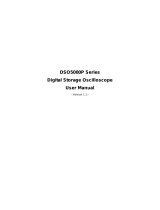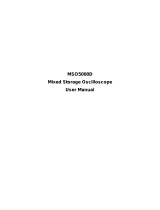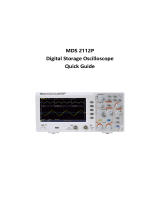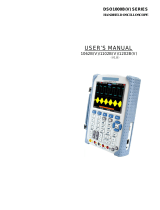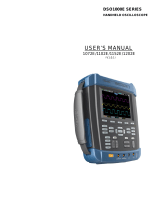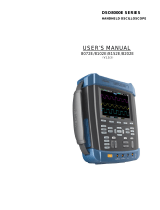Page is loading ...

User Manual
TDS 520 & 540
Digitizing Oscilloscopes
070-8317-01
This document supports Version 2 firmware.
Please check for change information at the rear
of this manual.
First Printing: March 1992
Last Revised: November 1992

Copyright Tektronix, Inc. 1991, 1992. All rights reserved.
Tektronix products are covered by U.S. and foreign patents, issued and pending. Information in this publication supercedes
that in all previously published material. Specifications and price change privileges reserved.
Printed in the U.S.A.
Tektronix, Inc., P.O. Box 1000, Wilsonville, OR 97070–1000
TEKTRONIX and TEK are registered trademarks of Tektronix, Inc.
Microsoft is a registered trademark of Microsoft Corporation
IBM is a registered trademark of International Business Machines
GPIB-PCII and GPIB-PCIIA are registered trademarks of National Instruments Corporation
Epson is a registered trademark of Epson America, Inc.
Interleaf is a trademark of Interleaf, Inc.
PostScript is a registered trademark of Adobe Systems Incorporated

WARRANTY
Tektronix warrants that the products that it manufactures and sells will be free from defects in materials and
workmanship for a period of three (3) years from the date of shipment. If a product proves defective during this
warranty period, Tektronix, at its option, either will repair the defective product without charge for parts and labor,
or will provide a replacement in exchange for the defective product.
In order to obtain service under this warranty, Customer must notify Tektronix of the defect before the expiration
of the warranty period and make suitable arrangements for the performance of service. Customer shall be
responsible for packaging and shipping the defective product to the service center designated by Tektronix, with
shipping charges prepaid. Tektronix shall pay for the return of the product to Customer if the shipment is to a
location within the country in which the Tektronix service center is located. Customer shall be responsible for
paying all shipping charges, duties, taxes, and any other charges for products returned to any other locations.
This warranty shall not apply to any defect, failure or damage caused by improper use or improper or inadequate
maintenance and care. Tektronix shall not be obligated to furnish service under this warranty a) to repair damage
resulting from attempts by personnel other than Tektronix representatives to install, repair or service the product;
b) to repair damage resulting from improper use or connection to incompatible equipment; c) to repair any
damage or malfunction caused by the use of non-Tektronix supplies; or d) to service a product that has been
modified or integrated with other products when the effect of such modification or integration increases the time
or difficulty of servicing the product.
THIS WARRANTY IS GIVEN BY TEKTRONIX IN LIEU OF ANY OTHER WARRANTIES, EXPRESS
OR IMPLIED. TEKTRONIX AND ITS VENDORS DISCLAIM ANY IMPLIED WARRANTIES OF
MERCHANTABILITY OR FITNESS FOR A PARTICULAR PURPOSE. TEKTRONIX’
RESPONSIBILITY TO REPAIR OR REPLACE DEFECTIVE PRODUCTS IS THE SOLE AND
EXCLUSIVE REMEDY PROVIDED TO THE CUSTOMER FOR BREACH OF THIS WARRANTY.
TEKTRONIX AND ITS VENDORS WILL NOT BE LIABLE FOR ANY INDIRECT, SPECIAL,
INCIDENTAL, OR CONSEQUENTIAL DAMAGES IRRESPECTIVE OF WHETHER TEKTRONIX OR
THE VENDOR HAS ADVANCE NOTICE OF THE POSSIBILITY OF SUCH DAMAGES.

This apparatus has been designed and tested in accordance with IEC Publication 348, Safety Requirements for
Electronic Measuring Apparatus, and has been supplied in a safe condition. This manual contains some
information and warnings which have to be followed by the user to ensure safe operation and to retain the
apparatus in safe condition.
The apparatus has been designed for indoor use. It may occasionally be subjected to temperatures between +5 C
and –10 C without degradation of its safety.

TDS 520 & TDS 540 User Manual
Welcome
This is the User Manual for the TDS 520 and TDS 540 Digitizing Oscillo-
scopes.
If you are a new user, try the
Tutorial
section to become familiar with the
operation of your digitizing oscilloscope.
The
Concepts
section covers basic principles of the operation of the oscillo-
scope. These articles help you understand why your instrument works the
way it does.
Use the
In Detail
section to learn how to perform specific tasks. See page 3-1
for a complete list of tasks covered in that section.
The
Appendices
provide an option and accessories listing, product specifica-
tion, and other useful information.
The following documents are related to the use or service of the digitizing
oscilloscope.
The
TDS Family Programmer Manual
(Tektronix part number
070-8318-03) describes using a computer to control the digitizing oscillo-
scope through the GPIB interface.
The
TDS 520 & 540 Reference
(Tektronix part number 070-8316-01)
gives you a quick overview of how to operate your digitizing oscilloscope.
The
TDS Family Option 2F Instruction Manual
(Tektronix part number
070-8582-00) describes use of the Advanced DSP Math option (for TDS
oscilloscopes equipped with that option only).
The
TDS Family Option 13 Instruction Manual
(Tektronix part number
070-8567-00) describes using the optional Centronics and RS-232
interfaces for obtaining hardcopy (for TDS oscilloscopes equipped with
that option only).
The
TDS 520
&
TDS 540
Performance Verification
(Tektronix part number
070-8603-00) tells how to verify the performance of the digitizing oscillo-
scope.
The
TDS 520
Service Manual
(Tektronix part number 070-8312-01) and
the
TDS 540 Service Manual
(070-8314-01) provide information for
maintaining and servicing your digitizing oscilloscope to the module level.
Related Manuals

Welcome
In the
Tutorial
and
In Detail
sections, you will find various procedures which
contain steps of instructions for you to perform. To keep those instructions
clear and consistent, this manual uses the following conventions:
Names of front panel controls and menu labels appear in boldface print.
Names also appear in the same case (initial capitals, all uppercase, etc.)
in the manual as is used on the oscilloscope front panel and menus. Front
panel names are all upper case letters, for example, VERTICAL MENU,
CH 1, etc.
Instruction steps are numbered. The number is omitted if there is only
one step.
When steps require that you make a sequence of selections using front
panel controls and menu buttons, an arrow ( ➞
) marks each transition
between a front panel button and a menu, or between menus. Also,
whether a name is a main menu or side menu item is clearly indicated:
Press VERTICAL MENU ➞ Coupling (main) ➞ DC (side) ➞ Band-
width (main) ➞ 100 MHz (side).
Using the convention just described results in instructions that are graphi-
cally intuitive and simplifies procedures. For example, the instruction just
given replaces these five steps:
1. Press the front panel button VERTICAL MENU.
2. Press the main menu button Coupling.
3. Press the side-menu button DC.
4. Press the main menu button Bandwidth
5. Press the side menu button 100 MHz
Sometimes you may have to make a selection from a popup menu: Press
TRIGGER MENU ➞ Type (main) ➞ Edge (popup). In this example, you
repeatedly press the main menu button Type until Edge is highlighted in
the pop-up menu.
Conventions

TDS 520 & TDS 540 User Manual
Contents
Product Description v. . . . . . . . . . . . . . . . . . . . . . . . . . . . . . . . . . . . . . . . .
Safety vi. . . . . . . . . . . . . . . . . . . . . . . . . . . . . . . . . . . . . . . . . . . . . . . . . . . . . .
Start Up viii. . . . . . . . . . . . . . . . . . . . . . . . . . . . . . . . . . . . . . . . . . . . . . . . . . . .
Tutorial
Overview 1-1. . . . . . . . . . . . . . . . . . . . . . . . . . . . . . . . . . . . . . . . . . . . . . . . . . .
Example 1: Displaying a Waveform 1-2. . . . . . . . . . . . . . . . . . . . . . . . . . .
Example 2: Multiple Waveforms 1-8. . . . . . . . . . . . . . . . . . . . . . . . . . . . . .
Example 3: Automated Measurements 1-12. . . . . . . . . . . . . . . . . . . . . . . .
Example 4: Saving Setups 1-18. . . . . . . . . . . . . . . . . . . . . . . . . . . . . . . . . . .
Concepts
Overview 2-1. . . . . . . . . . . . . . . . . . . . . . . . . . . . . . . . . . . . . . . . . . . . . . . . . . .
Triggering 2-2. . . . . . . . . . . . . . . . . . . . . . . . . . . . . . . . . . . . . . . . . . . . . . . . . .
Acquisition 2-7. . . . . . . . . . . . . . . . . . . . . . . . . . . . . . . . . . . . . . . . . . . . . . . . .
Scaling and Positioning Waveforms 2-13. . . . . . . . . . . . . . . . . . . . . . . . . .
Measurements 2-17. . . . . . . . . . . . . . . . . . . . . . . . . . . . . . . . . . . . . . . . . . . . . .
In Detail
Overview 3-1. . . . . . . . . . . . . . . . . . . . . . . . . . . . . . . . . . . . . . . . . . . . . . . . . . .
At a Glance 3-2. . . . . . . . . . . . . . . . . . . . . . . . . . . . . . . . . . . . . . . . . . . . . . . . .
Acquisition Modes 3-11. . . . . . . . . . . . . . . . . . . . . . . . . . . . . . . . . . . . . . . . . .
Autoset 3-18. . . . . . . . . . . . . . . . . . . . . . . . . . . . . . . . . . . . . . . . . . . . . . . . . . . . .
Cursor Measurements 3-20. . . . . . . . . . . . . . . . . . . . . . . . . . . . . . . . . . . . . . .
Delayed Triggering 3-25. . . . . . . . . . . . . . . . . . . . . . . . . . . . . . . . . . . . . . . . . .
Display Modes 3-31. . . . . . . . . . . . . . . . . . . . . . . . . . . . . . . . . . . . . . . . . . . . . .
Edge Triggering 3-36. . . . . . . . . . . . . . . . . . . . . . . . . . . . . . . . . . . . . . . . . . . . .
Hardcopy 3-40. . . . . . . . . . . . . . . . . . . . . . . . . . . . . . . . . . . . . . . . . . . . . . . . . . .

Contents
Help 3-48. . . . . . . . . . . . . . . . . . . . . . . . . . . . . . . . . . . . . . . . . . . . . . . . . . . . . . . .
Horizontal Control 3-49. . . . . . . . . . . . . . . . . . . . . . . . . . . . . . . . . . . . . . . . . . .
Limit Testing 3-53. . . . . . . . . . . . . . . . . . . . . . . . . . . . . . . . . . . . . . . . . . . . . . . .
Logic Triggering 3-58. . . . . . . . . . . . . . . . . . . . . . . . . . . . . . . . . . . . . . . . . . . . .
Measurement System 3-66. . . . . . . . . . . . . . . . . . . . . . . . . . . . . . . . . . . . . . . .
Probe Accessories 3-77. . . . . . . . . . . . . . . . . . . . . . . . . . . . . . . . . . . . . . . . . .
Probe Cal 3-84. . . . . . . . . . . . . . . . . . . . . . . . . . . . . . . . . . . . . . . . . . . . . . . . . . .
Probe Compensation 3-90. . . . . . . . . . . . . . . . . . . . . . . . . . . . . . . . . . . . . . . .
Probe Selection 3-92. . . . . . . . . . . . . . . . . . . . . . . . . . . . . . . . . . . . . . . . . . . . .
Pulse Triggering 3-99. . . . . . . . . . . . . . . . . . . . . . . . . . . . . . . . . . . . . . . . . . . . .
Remote Communication 3-106. . . . . . . . . . . . . . . . . . . . . . . . . . . . . . . . . . . . .
Saving and Recalling Setups 3-110. . . . . . . . . . . . . . . . . . . . . . . . . . . . . . . . .
Saving and Recalling Waveforms 3-112. . . . . . . . . . . . . . . . . . . . . . . . . . . . .
Selecting Channels 3-115. . . . . . . . . . . . . . . . . . . . . . . . . . . . . . . . . . . . . . . . . .
Signal Path Compensation 3-117. . . . . . . . . . . . . . . . . . . . . . . . . . . . . . . . . . .
Status 3-119. . . . . . . . . . . . . . . . . . . . . . . . . . . . . . . . . . . . . . . . . . . . . . . . . . . . . .
Triggering 3-120. . . . . . . . . . . . . . . . . . . . . . . . . . . . . . . . . . . . . . . . . . . . . . . . . .
Vertical Control 3-124. . . . . . . . . . . . . . . . . . . . . . . . . . . . . . . . . . . . . . . . . . . . .
Waveform Math 3-127. . . . . . . . . . . . . . . . . . . . . . . . . . . . . . . . . . . . . . . . . . . . .
Zoom 3-130. . . . . . . . . . . . . . . . . . . . . . . . . . . . . . . . . . . . . . . . . . . . . . . . . . . . . . .
Appendices
Appendix A: Options and Accessories A-1. . . . . . . . . . . . . . . . . . . . . . . .
Appendix B: Specification A-9. . . . . . . . . . . . . . . . . . . . . . . . . . . . . . . . . . .
Appendix C: Algorithms A-25. . . . . . . . . . . . . . . . . . . . . . . . . . . . . . . . . . . . .
Appendix D: Packaging for Shipment A-39. . . . . . . . . . . . . . . . . . . . . . . . .
Appendix E: Factory Initialization Settings A-41. . . . . . . . . . . . . . . . . . . .
Glossary & Index
Change Information

TDS 520 & TDS 540 User Manual
Product Description
Your Tektronix digitizing oscilloscope is a superb tool for acquiring, displaying,
and measuring waveforms. Its performance addresses the needs of both
benchtop lab and portable applications with the following features:
500 MHz maximum analog bandwidth.
1 Gigasample/second maximum digitizing rate (TDS 540);
500 Megasamples/second maximum digitizing rate (TDS 520).
Four-channel acquisition—the TDS 540 offers four full-featured channels;
the TDS 520 offers two full-featured channels and two channels with
limited vertical scale selections: 100 mV, 1 V, and 10 V.
Waveform Math—Invert a single waveform and add, subtract, and multiply
two waveforms. On instruments equipped with option 2F, integrate or
differentiate a single waveform or perform an FFT (fast fourier transform)
on a waveform to display its magnitude or phase versus its frequency.
Eight-bit digitizers.
Up to 15,000-point record length per channel (50,000-point optional).
Full GPIB software programmability. GPIB hardcopy output. On instru-
ments equipped with option 13, hardcopy output using the RS-232 or
Centronics ports.
Complete measurement and documentation capability.
Intuitive graphic icon operation blended with the familiarity of traditional
horizontal and vertical knobs.
On-line help at the touch of a button.

Safety
Safety
Please take a moment to review these safety precautions. They are provided
for your protection and to prevent damage to the digitizing oscilloscope. This
safety information applies to all operators and service personnel.
These two terms appear in manuals:
statements identify conditions or practices that could result in
damage to the equipment or other property.
statements identify conditions or practices that could result in
personal injury or loss of life.
These two terms appear on equipment:
CAUTION
indicates a personal injury hazard not immediately accessible
as one reads the marking or a hazard to property including the equipment
itself.
DANGER
indicates a personal injury hazard immediately accessible as
one reads the marking.
This symbol appears in manuals:
Static-Sensitive Devices
These symbols appear on equipment:
DANGER
High Voltage
Protective
ground (earth)
terminal
ATTENTION
Refer to
manual
Symbols and Terms

Safety
TDS 520 & TDS 540 User Manual
Observe all of these precautions to ensure your personal safety and to pre-
vent damage to either the digitizing oscilloscope or equipment connected to it.
Power Source
The digitizing oscilloscope is intended to operate from a power source that will
not apply more than 250 V
rms
between the supply conductors or between
either supply conductor and ground. A protective ground connection, through
the grounding conductor in the power cord, is essential for safe system
operation.
Grounding the Digitizing Oscilloscope
The digitizing oscilloscope is grounded through the power cord. To avoid
electric shock, plug the power cord into a properly wired receptacle where
earth ground has been verified by a qualified service person. Do this before
making connections to the input or output terminals of the digitizing oscillo-
scope.
Without the protective ground connection, all parts of the digitizing oscillo-
scope are potential shock hazards. This includes knobs and controls that may
appear to be insulators.
Use the Proper Power Cord
Use only the power cord and connector specified for your product. Use only a
power cord that is in good condition.
Use the Proper Fuse
To avoid fire hazard, use only the fuse specified in the parts list for your
product, matched by type, voltage rating, and current rating.
Do Not Remove Covers or Panels
To avoid personal injury, do not operate the digitizing oscilloscope without the
panels or covers.
Electric Overload
Never apply a voltage to a connector on the digitizing oscilloscope that is
outside the voltage range specified for that connector.
Do Not Operate in Explosive Atmospheres
The digitizing oscilloscope provides no explosion protection from static dis-
charges or arcing components. Do not operate the digitizing oscilloscope in
an atmosphere of explosive gases.
Specific Precautions

Start Up
Start Up
Before you use the digitizing oscilloscope, ensure that it is properly installed
and powered on.
To properly install and power on the digitizing oscilloscope, do the following:
Installation
1. Be sure you have the appropriate operating environment. Specifications
for temperature, relative humidity, altitude, vibrations, and emissions are
included in
Appendix B: Specification
at the rear of this manual.
2. Leave space for cooling. Do this by verifying that the air intake and ex-
haust holes on the sides of the cabinet (where the fan operates) are free
of any airflow obstructions. Leave at least 2 inches (5.1 cm) free on each
side.
To avoid electrical shock, be sure that the power cord is discon-
nected before checking the fuse.
3. Check the fuse to be sure it is the proper type and rating (Figure i). You
can use either of two fuses. Each fuse requires its own cap (see Table i).
The digitizing oscilloscope is shipped with the UL approved fuse installed.
4. Check that you have the proper electrical connections. The digitizing
oscilloscope requires 90 to 250 VAC
rms
, continuous range, 47 Hz to
63 Hz, and may require up to 300 W.
5. Connect the proper power cord from the rear-panel power connector
(Figure i) to the power system.
Operation

Start Up
TDS 520 & TDS 540 User Manual
Power Connector
Principal Power Switch
Fuse
Figure i: Rear Panel Controls Used in Start Up
Table i: Fuse and Fuse Cap Part Numbers
Fuse
Fuse Part
Number
Fuse Cap Part
Number
.25 inch 1.25 inch (UL 198.6, 3AG):
6 A FAST, 250 V.
159–0013–00 200–2264–00
5 mm 20 mm (IEC 127): 5 A (T),
250 V.
159–0210–00 200–2265–00
Power On
1. Check that the rear-panel principal power switch is on (Figure i). The
principal power switch controls all AC power to the instrument.
2. If the oscilloscope is not powered on (the screen is blank), push the
front-panel ON/STBY button to toggle it on (Figure ii).
The ON/STBY button controls power to most of the instrument circuits.
Power continues to go to certain parts even when this switch is set to
STBY.
Once the digitizing oscilloscope is installed, you can leave the principal
power switch on and use the ON/STBY button as the power switch.

Start Up
ON/STBY Button
Figure ii: ON/STBY Button
Self Test
The digitizing oscilloscope automatically performs power-on tests each time it
is turned on. It will come up with a display screen that states whether or not it
passed self test. (If the self test passed, the status display screen will be
removed after a few seconds.)
Check the self test results.
If the self test fails, call your local Tektronix Service Center. Depending on the
type of failure, you may still be able to use the oscilloscope before it is serv-
iced.
Power Off
Press the ON/STBY switch to turn off the oscilloscope.
Now that you have set up your oscilloscope for operation, you should know
about two features that help to ensure maximum accuracy for your most
critical measurements,
Signal Path Compensation
and
Probe Cal.
Signal Path Compensation (SPC)
lets you compensate your oscilloscope for
the current ambient temperature, helping to ensure maximum possible accu-
racy for your most critical measurements. See
Signal Path Compensation
on
page 3-117 for a description of and operating information on this key feature.
Before You Begin

Start Up
TDS 520 & TDS 540 User Manual
Probe Cal
lets you compensate any channel of your oscilloscope for the effect
of the probe on gain accuracy and offset accuracy. Like SPC, Probe Cal helps
ensure maximum possible accuracy for your most critical measurements. See
Probe Cal
on page 3-84 for a description of and operating information on this
feature.

Start Up

Tutorial


TDS 620 & 640 User Manual
Overview
This section contains four examples that show you how to operate the basic
functions of the digitizing oscilloscope. Use the
At a Glance
section (starting
on page 3-2) to help you locate the correct knobs, buttons, and menus.
Example 1
teaches you how to reset the digitizing oscilloscope, display
and adjust waveforms, and use the autoset function.
Example 2
explains how to add, control, and delete multiple waveforms.
Example 3
introduces you to the automated measurement system.
Example 4
discusses saving and recalling the digitizing oscilloscope
setups.
Before you perform these examples, read
Conventions
on page ii. If you
decide to skip this tutorial, use the
Concepts
and
In Detail
sections to learn
about the digitizing oscilloscope arrangement and specific functions.
All the examples use the same setup. Once you perform this setup, you do
not have to change the signal connections for any of the other examples.
Remove all probes and signal inputs from the input BNC connectors along the
lower right of the front panel. Then, using one of the probes supplied with the
digitizing oscilloscope, connect from the CH 1 connector to the PROBE
COMPENSATION connectors (Figure 1-1).
Figure 1-1: Connecting a Probe for the Examples
Setting Up for the
Examples

Section Name (Nm:Sect)
Example 1: Displaying a Waveform
In this first example you learn about resetting the digitizing oscilloscope,
displaying and adjusting a waveform, and using the autoset function.
All examples in the tutorial begin by resetting the digitizing oscilloscope to a
known factory default state. Reset the oscilloscope when you begin a new
task and need to “start fresh” with known default settings.
1. Press the save/recall SETUP button to display the Setup menu (Fig-
ure 1-2).
SETUP Button
Figure 1-2: SETUP Button Location
The digitizing oscilloscope displays
main menus
along the bottom of the
screen. Figure 1-3 shows the Setup main menu.
Recall Factory Setup
Menu Item and Button
OK Confirm Factory Init
Menu Item and Button
Figure 1-3: The Displayed Setup Menu
Resetting the
Digitizing
Oscilloscope
/
